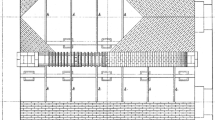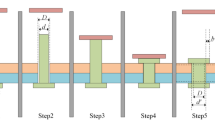Abstract
Load carrying capacity of reticulated space structures majorly depend on the structures’ imperfections. Imperfections in initial curvature, length, and residual stress of members are all innately random and can affect the load-bearing capacity of the members and consequently that of the structure. The present study investigated the effect of the probability distribution of initial curvature imperfection and lack of fit of members on the load-bearing capacity of double-layer barrel vault space structures with different types of support. A random number was first assigned to each member using gamma and normal distributions for initial curvature and member length imperfections, respectively. Afterwards, the ultimate bearing capacity and the collapse behavior of the structure was determined using nonlinear finite-element analysis in OpenSees software and finally structures reliability was acquired. The results demonstrate that the collapse behavior of doable-layer barrel vault space structures is sensitive to the random distribution of initial imperfections.
Similar content being viewed by others
References
Affan, A., Calladine, C.R., (1989). “Initial bar tensions in pin-jointed assembles.” International Journal of Space Structures, 4 (1), pp. 1–16.
AISC, (2010). American Institute of Steel Construction, ANSI/AISC360-10: Specification for Structural Steel Buildings, AISC, Chicago, Illinois, USA.
Broggi, M. and Schuëller, G. I., (2011). “Efficient modeling of imperfections for buckling analysis of composite cylindrical shells.” Engineering Structures, 33 (5), pp. b1796–1806.
De Paor, C., Cronin, K., Gleeson, J. P., & Kelliher, D., (2012). “Statistical characterisation and modelling of random geometric imperfections in cylindrical shells.” Thin-Walled Structures, 58, pp. 9–17.
El-Sheikh, A., (1991). The effect of composite action on the behavior of space structures. Ph.D. Thesis, University of Cambridge, UK.
El-Sheikh, A., (1995). “Sensitivity of space trusses to member geometric imperfections.” International Journal of Space Structures, 10 (2), pp. 89–98.
El-Sheikh, A., (1997). “Effect of member length imperfections on triple-layer space trusses.” Engineering Structures, 19 (7), pp. 540–550.
El-Sheikh, A., (2002). “Effect of geometric imperfections on single-layer barrel vaults.” International Journal of Space Structures, 17 (4), pp. 271–283.
Kala, Z., (2013). “Elastic Lateral-Torsional Buckling of Simply Supported Hot-Rolled Steel I-Beams with Random Imperfections.” Procedia Engineering, 57, pp. 504–514.
Karpov, E. G., Stephen, N. G., & Liu, W. K., (2003). “Initial tension in randomly disordered periodic lattices.” International journal of solids and structures, 40 (20), pp. 5371–5388.
McKenna, F. Fenves, GL.and Scott MH., (2000). Open system for earthquake engineering simulation. Pacific Earthquake Engineering Research Center, University of California, Berkeley, Available from http://opensees. berkeley.edu.
Melchers, R.E., (1999). Structural Reliability Analysis and Prediction. John Wiley & Sons, Second Edition.
Nowak A. S. and Collins K. R., (2000). Reliability of Structures, Mc. Graw Hill.
Schenk, C. A. and Schuëller, G.I., (2007). “Buckling analysis of cylindrical shells with cutouts including random boundary and geometric imperfections.” Computer Methods in Applied Mechanics and Engineering, 196 (35), pp. 3424–3434.
Schenk Christian A. and Schuëller, G.I., (2005). “12 Stability Analysis of Cylindrical Shells with Random Imperfections.” Uncertainty Assessment of Large Finite Element Systems, 24, pp. 81–109.
Schmidt, L.C., Morgan, P.R., Clarkson, J.A., (1976). “Space trusses with brittle-type strut buckling.” Journal of the Structural Division, ASCE, 102 (7), pp. 1479–1492.
Schmidt, L.C., Morgan, P.R., Gregg, B.M., (1983). “Correlation study of ultimate load capacities of space trusses.” In: Morris, L.J. (Ed.), Instability and Plastic Collapse of Steel Structures. Granada, London, pp. 195–204.
Schuëller, G. I., (1987). “A prospective study of materials based on stochastic methods.” Materials and Structures, 20 (4), pp. 243–248.
Smith, E.A., Epstein, H.I., (1980). “Hartford Coliseum roof collapse: structural collapse sequence and lessons learned.” Civil Engineering, ASCE, 50, pp. 59–62.
Thornton, C.H., Lew, P., (1984). “Investigation of the causes of Hartford Coliseum collapse.” In: Nooshin, H. (Ed.), Proceedings of the 3rd International Conference on Space Structures. Elsevier Applied Science Publishers, pp. 636–641.
Vryzidis, I., Stefanou, G., & Papadopoulos, V., (2013). “Stochastic stability analysis of steel tubes with random initial imperfections.” Finite Elements in Analysis and Design, 77, pp. 31–39.
Wada, A., & Wang, Z., (1991). Influences of uncertainties on mechanical behavior of a double-layer space truss. Research Laboratory of Engineering Materials, Report, 16, 281–297.
Zhao, J., Zhang, Y., & Lin, Y., (2014). “Study on mid-height horizontal bracing forces considering random initial geometric imperfections.” Journal of Constructional Steel Research, 92, pp. 55–66.
Author information
Authors and Affiliations
Corresponding author
Rights and permissions
About this article
Cite this article
Tahamouli Roudsari, M., Gordini, M., Fazeli, H. et al. Probability analysis of double layer barrel vaults considering the effect of initial curvature and length imperfections simultaneously. Int J Steel Struct 17, 939–948 (2017). https://doi.org/10.1007/s13296-017-9006-9
Received:
Accepted:
Published:
Issue Date:
DOI: https://doi.org/10.1007/s13296-017-9006-9




